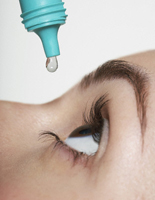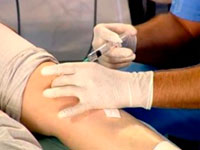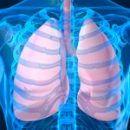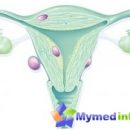Types of sclerodermia: focal, systemic, generalized. How to treat sclerodermia? All information can be found in the article.
Content
Sclerodermia
Sclerodermia is one of the main diseases of the connective tissue (collagenosis), characterized by its seal (sclerosis), mainly on the skin.
Types of sclerodermia
Heat sclerodermia (limited). This form of sclerodermia proceeds relatively benign. In the development of the disease distinguish three stages: skin swelling, its seal and sclerosis, then atrophy and pigmentation. There is a focus of defeat (gloaching character) most often on the torso, less often on the limbs. It is characterized by the formation of sharply limited pinkish-blue (purple-red) rounded or oval spots with palm, which are pretty quickly transformed into very dense (woody) plaques with a shiny, smooth surface resembling the color of the elephant bone (yellowish-white). Plaques in the process of growth are surrounded by a lilac ring, the hair falls out. Several months or years, they gradually soften and turn into a sector of scar atrophy of white. Limited form can sometimes have a view of a strip (belt-like sclerodermia).
Generalized sclerodermia. Initial symptoms of this form of cooling fingers, reduce their sensitivity and blue color. After many months, sclerosic skin becomes dense, like a tree, smooth, shiny, fixed. Trophic ulcers often occur on its surfaces. After 2-3 years, the skin is involved in the process. Face acquires a mask.
The oral hole is narrowed by the nose in the cartilage part, taking a beak shape. Internal organs are affected, progressively worsening the patient's condition.
In the treatment, hesoys eliminate the foci of chronic infection, from which sensitization (infection) of the body. Advisory antibiotics of the penicillin group and hyaluroindase preparations (lipase, ronidase, vitreous body). Use vitamins and preparations that can expand peripheral vessels (complemin, nicotinic acid). The favorable effect of the appointment of adenosine-triphosphate (ATP), hyperbaric oxygenation. In the seal stage, physiotherapy procedures are used: ultrasound, massage, baths, mud, healing gymnastics, etc.D. Children, patients with sclerodermia, must be under the dispensary observation of the pediatrician, dermatologist and neuropathologist. Prevention consists in treating seborrhea, proper skin care.
Sclerodermia systemic. Chronic disease of the system of connective tissue and small vessels with a common lesion of the skin (sclerosis, fibrosis), the connecting and wedroom base of the internal organs.
The reason is unknown. Provoked by cooling, injury, infection, vaccination, etc. Masives family-genetic predisposition. Women are sick 3 times more often.
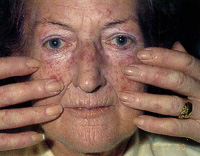 History of the disease: usually the systemic sclerodermia begins with Reyno syndrome, pain in the joints, weight loss, body temperature, weakness, fatigurity. The most characteristic feature is skin defeat. Initially, there is a dense common swelling, in the future - sealing and atrophy of the skin, especially expressed on the face and limbs. It is possible to appear the ulceration and guns on the tips of the fingers, long-lasting, very painful.
History of the disease: usually the systemic sclerodermia begins with Reyno syndrome, pain in the joints, weight loss, body temperature, weakness, fatigurity. The most characteristic feature is skin defeat. Initially, there is a dense common swelling, in the future - sealing and atrophy of the skin, especially expressed on the face and limbs. It is possible to appear the ulceration and guns on the tips of the fingers, long-lasting, very painful.
Deforming nails, fall out hair up to baldness. Painful seal, and then muscle atrophy is accompanied by rude changes of the tendons: they are shortened, which leads to the development of contractures that violate the activities of various joints. They have pains, they deform. When radiological examination, the destruction of the terminal is detected, and in severe cases and medium-sized hands, less frequently. In the thickness of the subcutaneous fiber can be postponed with calcium chuckles. The disease affects the cardiovascular system. There are pain in the heart, shortness of breath, various violations of heart rhythm and conduction.
In immune inflammation of vessels, gangrene may occur, thrombophlebitis with trophic ulcers in the footsteps, the legs, etc. Possible heavy lesions of the internal organs: the lungs - pneumophybrosis, kidneys - «Sclerodermic kidney», Diffuse glomerulonephritis. Especially characteristic of the violation of the passage of food on the esophagus, its expansion detected during a radiographic study.
The damage to the nervous system is manifested by polyneurite, vegetative instability (violation of sweating, thermoregulation), emotional (irritability, fiscaliness and imperidity), insomnia. In rare cases, encephalitis and psychosis occurs.
Eliminate acute, subacute and chronic course of the disease. Changes in blood nonspecific. The level of hemoglobin is reduced, the number of leukocytes, soe.
The diagnosis is confirmed by detecting specific changes in the immunological status and when skin biopsy.
Systemic sclerodermia refers to the competence of rheumatologists. For the treatment of systemic sclerodermia, large doses of glucocorticoid hormones are used (prednisone), as well as Dr. Penicilline, Curphenyl, made. For the treatment of Reino syndrome - Nifedipin (Corinthar, Cordafen, Foridon). Symptomatic therapy is needed: lidase, group vitamins, vasodilators, physiotherapy (coniferous, radon, hydrogen sulfide baths, mud, paraffin, and t.D.), therapeutic physical education, massage.



